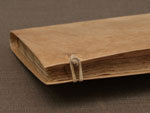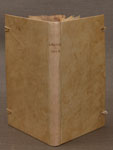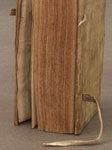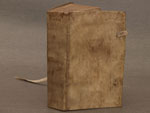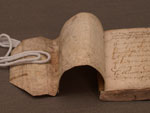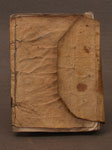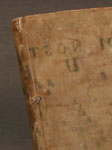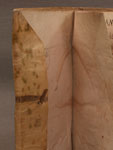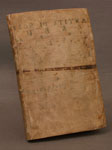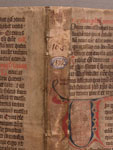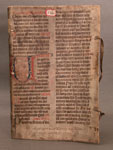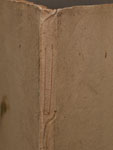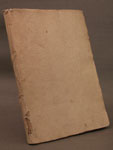Limp Bindings: The Ageless Book
Books in this case show a style, rather than an era. Limp structures, books without stiff covers, have been around since the beginning of the codex (2nd century AD). This structure can still be seen in our modern paperback books, although they look, and act, nothing like these earlier examples. Limp structures are typically covered in vellum, but paper is also used.
- Author:
- Rusius, Laurentius.
- Title:
- Opera de l'arte del malscalcio, di Lorenzo Rvsio, nellaquale si tratta delle razze, gouerno, & segni di tutte le qualita de caualli, & di molte malattie, con suoi rimedij. Con la discrittione di alcune maniere di morsi, nouamente de latino in lingua uolgare tradotta.
- Publisher:
- In Venetia, 1548.
- Call Number:
- SF 957 .R816 1548
A stiff vellum binding with title hand lettered on the spine. The leather hooks and loops are reminiscent of clasp structures used during the Coptic era.
- Author:
- Finch, Henry, Sir, d. 1625.
- Title:
- Lavv, or, A discourse thereof, in foure bookes / written in French by Sir Henrie Finch ... and done into English by the same author.
- Publisher:
- London : Printed for the Societie of Stationers, 1627.
- Call Number:
- KJ 147 .F5 1627
A full limp vellum binding. Leather thongs, mostly missing, were used to hold the book shut. Three sewing slips can be seen at the spine. The title has been handwritten on the spine. The covers have yapp edges, where the cover turns at a 90 degree angle towards the textblock.
- Title:
- A book of medysens and dryinges for horses
- Publisher:
- [157-?]
- Call Number:
- MS 79
This manuscript was stab sewn (through the thickness) with the threads visible on the cover. The vellum wraps around the spine with a fore edge flap. While the structure is from the 16th century, it is a good example of what the early codex looked like in the 2nd and 3rd centuries.
- Author:
- Apollaro, Gio.
- Title:
- Incommincia Il libro di miniscalcherìa, e capituli dell'infirmità de cavalli / quale fú cavato da Mró Gio: Apollaro mastro de stalla del ré Carlo, il quale molto fú esperto nella presente arte, secondo nel presente libro si descrive.
- Publisher:
- 1559.
- Call Number:
- MS 176
A stiff vellum binding with a fore edge flap. Two slips are visible at the spine. Vellum has lettering on the verso which can be seen on the outside.
- Author:
- Hochwirdigen
- Title:
- Fursten und herzen
- Publisher:
- Melchozn Bischoue, Wurzberg, 1561
- Call Number:
- European Crimonology Collection 637
A limp vellum binding with leather ties still extant. The sewing slips, which can be seen along the hinge show that this book was sewn on split alum-tawed thongs. The vellum for the cover has been reused from a manuscript, which was a fairly common practice during the early eras of bookbinding.
- Author:
- Ferri, Vincenzio.
- Title:
- La mascalcia toscana / di Vincenzio Ferri, maestro di stalla della cauallerizza del ... G.D. Ferdinando II di Toscana.
- Publisher:
- [late 17th cent.?]
- Call Number:
- MS181

